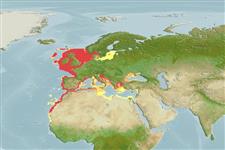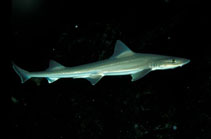Add your observation in Fish Watcher
| Native range | All suitable habitat | Point map | Year 2050 |

|
| This map was computer-generated and has not yet been reviewed. |
| Mustelus asterias AquaMaps Data sources: GBIF OBIS |
Upload your photos and videos
Pictures | Google imageMustelus asterias
Picture by Salesjö, A.
Pictures | Google imageMustelus asterias
Picture by Salesjö, A.
United Kingdom country information
Common names:
Morgi llyfn, Smooth-hound, Stellate smooth-hound
Occurrence: native
Salinity: marine
Abundance: common (usually seen) | Ref: Ellis, J.R., A. Cruz-Martinez, B.D. Rackham and S.I. Rodgers, 2005
Importance: | Ref:
Aquaculture: | Ref:
Regulations: | Ref:
Uses: no uses
Comments: Widespread around the British Isles (10-199 m), and most abundant along the southern and western coasts of the UK with high catch rates recorded in the outer Thames Estuary and Bristol Channel. Juveniles were caught frequently in the inshore waters of England and Wales, particularly off the south coast of England, outer part of the Thames Estuary and Bristol Channel (Ref. 82399).
National Checklist:
Country Information: https://www.cia.gov/library/publications/resources/the-world-factbook/geos/uk.html
National Fisheries Authority:
Occurrences: Occurrences Point map
Main Ref: Compagno, L.J.V., 1984
National Database:
Occurrence: native
Salinity: marine
Abundance: common (usually seen) | Ref: Ellis, J.R., A. Cruz-Martinez, B.D. Rackham and S.I. Rodgers, 2005
Importance: | Ref:
Aquaculture: | Ref:
Regulations: | Ref:
Uses: no uses
Comments: Widespread around the British Isles (10-199 m), and most abundant along the southern and western coasts of the UK with high catch rates recorded in the outer Thames Estuary and Bristol Channel. Juveniles were caught frequently in the inshore waters of England and Wales, particularly off the south coast of England, outer part of the Thames Estuary and Bristol Channel (Ref. 82399).
National Checklist:
Country Information: https://www.cia.gov/library/publications/resources/the-world-factbook/geos/uk.html
National Fisheries Authority:
Occurrences: Occurrences Point map
Main Ref: Compagno, L.J.V., 1984
National Database:
Common names from other countries
Classification / Names Κοινά ονόματα | Συνώνυμα | Catalog of Fishes(Γένος, Είδη) | ITIS | CoL | WoRMS | Cloffa
Ελασμοβράγχιοι (καρχαρίες και σαλάχια) (sharks and rays) > Carcharhiniformes (Ground sharks) > Triakidae (Houndsharks) > Triakinae
Etymology: Mustelus: Latin for weasel, an ancient name for sharks, possibly referring to the pointed snouts, swift movements and/or rapacious feeding behavior of smaller predatory sharks [strictly not tautonymous with Squalus mustelus Linnaeus 1758 since type was designated by the ICZN] (See ETYFish); asterias: Starry, referring to many small white spots on dorsal (upper) surface of body (See ETYFish).
Etymology: Mustelus: Latin for weasel, an ancient name for sharks, possibly referring to the pointed snouts, swift movements and/or rapacious feeding behavior of smaller predatory sharks [strictly not tautonymous with Squalus mustelus Linnaeus 1758 since type was designated by the ICZN] (See ETYFish); asterias: Starry, referring to many small white spots on dorsal (upper) surface of body (See ETYFish).
Environment: milieu / climate zone / depth range / distribution range Οικολογία
Θαλασσινό(ά) βενθικό(ς); εύρος βάθους 0 - 350 m (Ref. 6808). Temperate; 61°N - 16°N, 19°W - 36°E
Κατανομή Χώρες | Περιοχές FAO | Οικοσυστήματα | Παρουσίες | Point map | Εισαγωγές | Faunafri
Northeast Atlantic: British Isles and North Sea to Canary Islands, including the Mediterranean and Mauritania.
Length at first maturity / Μέγεθος / Βάρος / Age
Maturity: Lm 81.0, range 85 - ? cm
Max length : 154 cm TL αρσενικό/απροσδιόριστο; (Ref. 86318); μεγ. δημοσιευμένο βάρος: 4.8 kg (Ref. 4699)
Max length : 154 cm TL αρσενικό/απροσδιόριστο; (Ref. 86318); μεγ. δημοσιευμένο βάρος: 4.8 kg (Ref. 4699)
A common inshore and offshore shark found on the continental and insular shelves from the intertidal down to at least 100 m. Prefers sandy and gravelly bottom. Feeds primarily on crustaceans (crabs, hermit crabs, lobsters and slipper lobsters). Ovoviviparous (aplacental), with 7 to 15 young per litter. Size at birth about 30 cm. Utilized fresh and dried salted.
Life cycle and mating behavior Γεννητική Ωρίμανση | Αναπαραγωγή | Γεννοβολία | Αβγά | Γονιμότητα | Προνύμφες
Ovoviviparous, embryos feed solely on yolk (Ref. 50449).
Main reference
Upload your references | Αναφορές | Συντονιστής : Compagno, Leonard J.V. | Συνεργάτες
Compagno, L.J.V., 1984. FAO Species Catalogue. Vol. 4. Sharks of the world. An annotated and illustrated catalogue of shark species known to date. Part 2 - Carcharhiniformes. FAO Fish. Synop. 125(4/2):251-655. Rome: FAO. (Ref. 244)
IUCN Red List Status (Ref. 130435: Version 2024-1)
Near Threatened (NT) (A2d); Date assessed: 04 August 2020
Threat to humans
Harmless
Human uses
αλιεία: Εμπορικό(ά); αλιεία αναψυχής: ναί
FAO(αλιεία: Παραγωγή; publication : search) | FishSource | Η θάλασσα γύρω μας
Περισσότερες πληροφορίες
Population dynamics
Παράμετροι Αύξησης
Max. ages / sizes
Length-weight rel.
Length-length rel.
Length-frequencies
Mass conversion
Στρατολόγηση
Αφθονία
Παράμετροι Αύξησης
Max. ages / sizes
Length-weight rel.
Length-length rel.
Length-frequencies
Mass conversion
Στρατολόγηση
Αφθονία
Life cycle
Αναπαραγωγή
Γεννητική Ωρίμανση
Γονιμότητα
Γεννοβολία
Spawning aggregations
Αβγά
Egg development
Προνύμφες
Δυναμική προνυμφών
Αναπαραγωγή
Γεννητική Ωρίμανση
Γονιμότητα
Γεννοβολία
Spawning aggregations
Αβγά
Egg development
Προνύμφες
Δυναμική προνυμφών
Physiology
Body composition
Nutrients
Κατανάλωση οξυγόνου
Κολυμβητικός τύπος
Ταχύτητα κολύμβησης
Visual pigments
Fish sound
Diseases & Parasites
Toxicity (LC50s)
Body composition
Nutrients
Κατανάλωση οξυγόνου
Κολυμβητικός τύπος
Ταχύτητα κολύμβησης
Visual pigments
Fish sound
Diseases & Parasites
Toxicity (LC50s)
Human related
Aquaculture systems
Προφίλ υδατοκαλλιεργειών
Στελέχοι
Ciguatera cases
Stamps, coins, misc.
Aquaculture systems
Προφίλ υδατοκαλλιεργειών
Στελέχοι
Ciguatera cases
Stamps, coins, misc.
Εργαλεία
E-book | Οδηγός πεδίου | Κλείδες προσδιορισμού | Ανάλυση κατά μήκος συνθέσεων | Εργαλείο ιστορίας ζωής | Σημειακός χάρτης | Classification Tree
| Catch-MSY |
Special reports
Download XML
Διαδικτυακές πηγές
Aquatic Commons | BHL | Cloffa | Websites from users | Check FishWatcher | CISTI | Catalog of Fishes(Γένος, Είδη) | DiscoverLife | DORIS | ECOTOX | Faunafri | Fishtrace | GenBank(genome, nucleotide) | GloBI | GOBASE | | Google Books | Google Scholar | Google | IGFA World Record | MitoFish | Εθνικές βάσεις δεδομένων | Otolith Atlas of Taiwan Fishes | Δημόσια ενυδρεία | PubMed | Reef Life Survey | Scirus | SeaLifeBase | Δέντρο Ζωής | Wikipedia(Go, αναζήτηση) | World Records Freshwater Fishing | Zoobank | Zoological Record
Estimates based on models
Preferred temperature (Ref. 115969): 7 - 16.2, mean 10.1 (based on 587 cells).
Phylogenetic diversity index (Ref. 82804): PD50 = 0.5000 [Uniqueness, from 0.5 = low to 2.0 = high].
Bayesian length-weight: a=0.00174 (0.00146 - 0.00207), b=3.13 (3.08 - 3.18), in cm Total Length, based on LWR estimates for this species (Ref. 93245).
Τροφικό Επίπεδο (Ref. 69278): 3.6 ±0.3 se; based on diet studies.
Ελαστικότητα (Ref. 120179): Πολύ χαμηλό, ελάχιστος χρόνος για διπλασιασμό πληθυσμού > 14 έτη (tm=2-3; Fec=7).
Fishing Vulnerability (Ref. 59153): High to very high vulnerability (71 of 100).
Climate Vulnerability (Ref. 125649): Moderate to high vulnerability (49 of 100).




